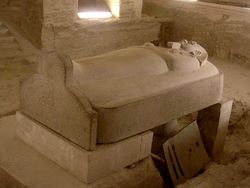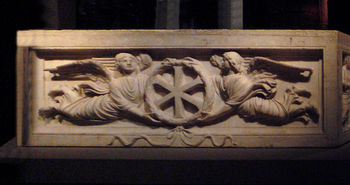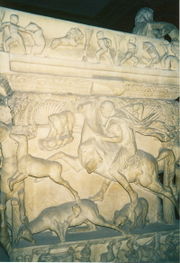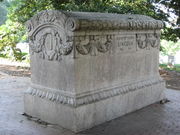Sarcophagus

A sarcophagus is a funeral receptacle for a corpse, most commonly carved or cut from stone. The word "sarcophagus" comes from the Greek σαρξ sarx meaning "flesh", and φαγειν phagein meaning "to eat", hence sarkophagus means "flesh-eating"; from the phrase lithos sarkophagos. (λιθος σαρκοφάγος) The word came to refer to the limestone that was thought to decompose the flesh of corpses interred within it.[1][2]
Contents |
Common forms

Sarcophagi were most often designed to remain above ground, hence were often ornately carved, decorated or elaborately constructed. Some were built to be freestanding, as a part of an elaborate tomb or series of tombs, while others were intended for placement in crypts. In Ancient Egypt, a sarcophagus formed the external layer of protection for a royal mummy, with several layers of coffins nested within, and was often carved out of alabaster.
Sarcophagi – sometimes metal or plaster as well as limestone – were also used by the ancient Romans until the early Christian burial preference for interment underground, often in a limestone sepulchre, led to their falling out of favor.[2]

See also




- Early Christian sarcophagi
- List of Egypt-related topics
- List of burials in the Valley of the Kings
References
- ↑ WordInfo etymology. As a noun the Greek term was further adopted to mean "coffin" and was carried over into Latin, where it was used in the phrase lapis sarcophagus, referring to those same properties of limestone.
- ↑ 2.0 2.1 Columbia University Department of Archaeology
External links
| This death-related article is a stub. You can help Wikipedia by expanding it. |